
Click the button to start reading
How to Create Engaging Social Media Content: Proven Examples
Boosting your online presence through social media content is essential in today’s digital landscape.
Like a recipe that requires the right ingredients and cooking techniques to make a delicious dish, creating engaging social media content involves careful planning and execution. But the results are worth it. Powerful social media content can help businesses build brand awareness, increase engagement, generate leads, and drive conversions.
In this blog post, we’ll explore seven techniques and ten real-world examples of what captivating social media content looks like. By learning from leading businesses, you’ll discover the secrets of how to create engaging social media content that resonates with your target audience.
So, grab a cup of coffee or tea, and let’s dive in.

1. Using the power of storytelling
The power of storytelling lies in its ability to create an emotional connection between the reader and the storyteller. When a story is well-crafted, it can evoke strong emotions, trigger memories, and inspire action.
Moreover, stories have the ability to communicate complex ideas in a way that’s easy to understand and remember.
Pro tip: Paint a vivid picture of your story with descriptive language and visuals (such as photos, videos, or graphics). Incorporating visuals into your storytelling will bring your narrative to life and make it more memorable.
Example: Patagonia tells the story of Afghan women who started a new chapter in their lives.
Patagonia is a clothing and outdoor gear brand. It demonstrates how to create engaging content on social media using the storytelling technique.
They frequently share stories of real people who use their products to connect with nature and live an adventurous lifestyle. These stories not only showcase the brand’s products but also tap into the emotions and values of their target audience.
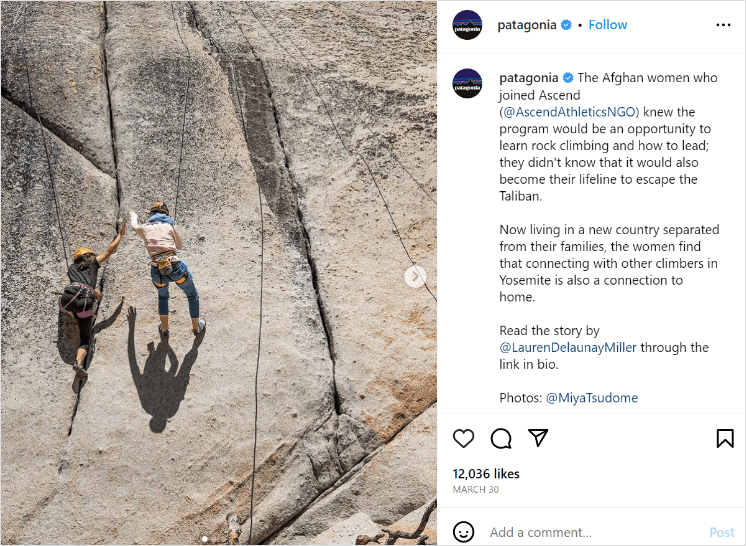
Image source: Patagonia Instagram page
The screenshot above showcases a story about Afghan women who started learning rock climbing and eventually found their lifeline to escape the Taliban. It’s a story that can create an emotional connection with their followers and make their brand more human.
2. Unlocking the potential of user-generated content
Worried about creating social media content that feels forced or salesy? You’re not alone. Today’s consumers are savvy and can spot inauthentic marketing from a mile away. That’s where user-generated content (UGC) comes in.
By harnessing the power of UGC, businesses can create authentic, trustworthy content that resonates with their audience.
For instance, if you have a makeup brand, encourage your followers to share photos and videos of themselves using your products. To keep track of all posts, ask them to include a unique hashtag created specifically for your campaign. Examples of such campaigns are #PutACanOnIt from Red Bull and #TweetFromTheSeat by Charmin.
Another form of user-generated content can be sharing your customers’ testimonials and reviews about your products or services.
Pro tip: Before sharing UGC, always ask the original creator for permission to use their content. This not only shows respect for their work but also protects you from any potential copyright issues. Additionally, using tools to watermark photos can protect the originality of user-generated content, ensuring credit is given where it’s due.
Example: GoPro brings together individuals who share a passion for adventure.
GoPro is a camera brand that encourages its followers to create and share their own content using their cameras. They often feature user-generated content on their social media accounts, showcasing the adventurous lifestyles of their customers.
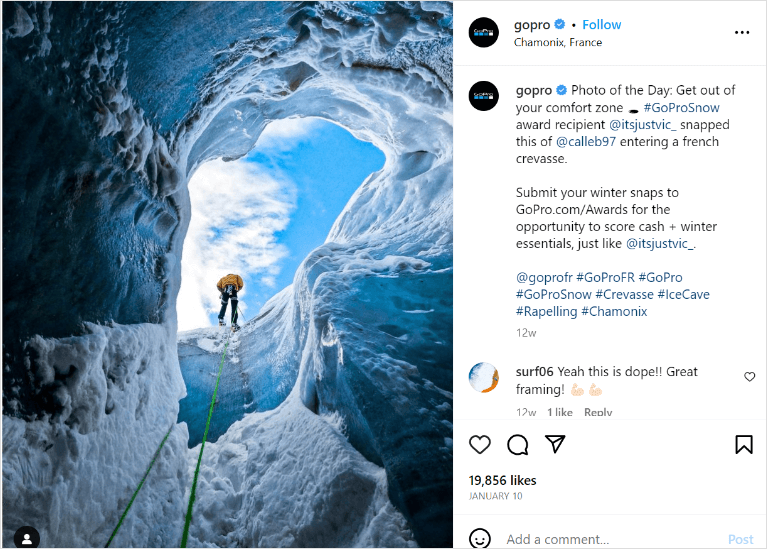
Image source: GoPro Instagram page
GoPro may share customer-submitted images and videos depicting people conquering difficult routes, riding waves, or skydiving. This content showcases both the quality of GoPro’s cameras and their ability to evoke an emotional response from their audience.
Example: Glossier prefers heartwarming shots (instead of expensive models and staged photo sessions)
Glossier, a beauty brand, relies on customer-generated visuals to promote its products. Instead of expensive models, they showcase real people using their products. Thus, they make their customers feel beautiful and confident again.
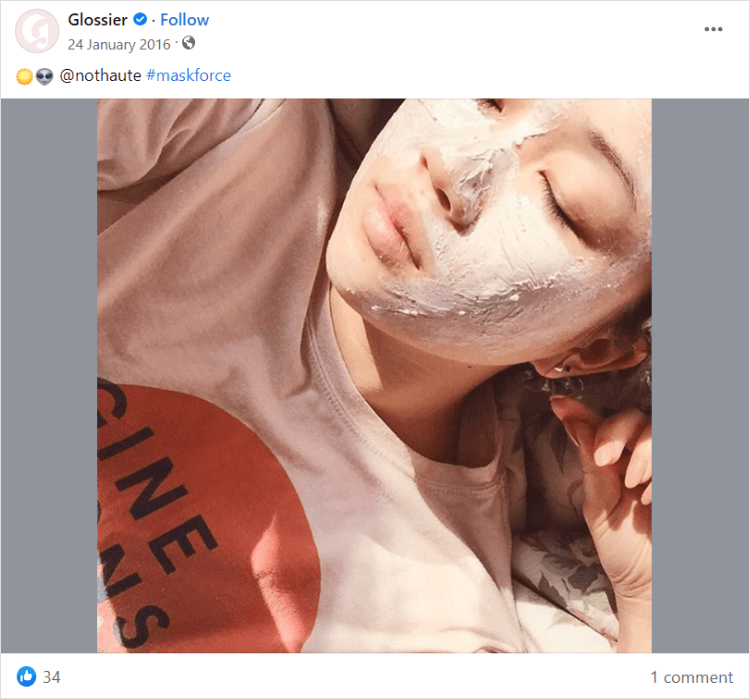
Image source: Glossier Facebook page
A case in place: when they launched their Mega Greens Galaxy Pack, thousands of consumers shared photos using the #MaskForce hashtag. Glossier reposted these photos, leading to even greater user engagement.
3. Sharing before-and-after photos
Who wants visual evidence of the benefits your brand provides? Everyone does!
Before-and-after photos can be a great example of how to create content for social media. They easily highlight the benefits of your products or services and inspire potential customers. These photos also help build trust and credibility with potential customers by highlighting the transformation people strive for.
Pro tip: Use captions and visuals to highlight the change shown in the photos. For instance, a skincare brand shares before-and-after photos of a customer who struggled with acne. The caption might highlight the specific changes in the customer’s skin. Alternatively, you can include customer testimonials to provide context and add credibility to the transformation shown in the photos.
Example: Havenly makes the transformation visual
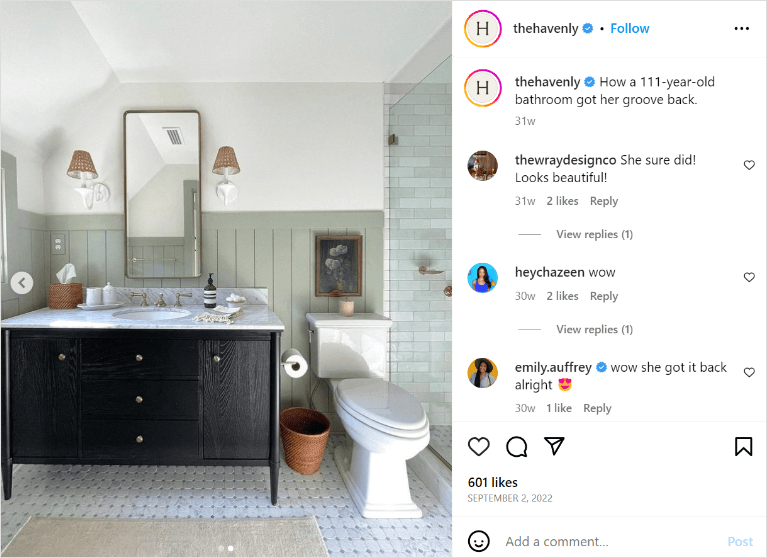
Image source: Havenly Instagram page
An online interior design service, Havenly often features before-and-after photos on its social media pages. With this, they showcase the dramatic transformations they can create.
In the example above, Havenly shares a set of before-and-after photos of a bathroom makeover, highlighting the changes made to the room’s layout, furniture, and decor. The photos showcase the effectiveness of the company’s service while also evoking the aspirations of its target audience. Definitely, a good example of how to create engaging content on social media.
4. Injecting a touch of humor into content
Spice up your content with humor and have fun with your followers.
By using humor, you can create social media content that helps your brand stand out in a crowded marketplace. Why? Because it reinforces your positioning as a fun brand. Plus, it helps to add a playful, lighthearted tone to your content which creates a positive connection with your followers.
Go creative. Use puns and jokes to create clever, memorable content. For example, Dollar Shave Club had a memorable slogan, using the wordplay “Shave time. Shave Money.
Pro tip: Make sure your humor is appropriate. What might be funny to one group of people might not be funny to another. For example, a fast food chain might use humor to appeal to a younger demographic, while a financial institution might use a more subtle, sophisticated type of humor to appeal to an older, more professional demographic.
Example: Have a good laugh with Old Spice
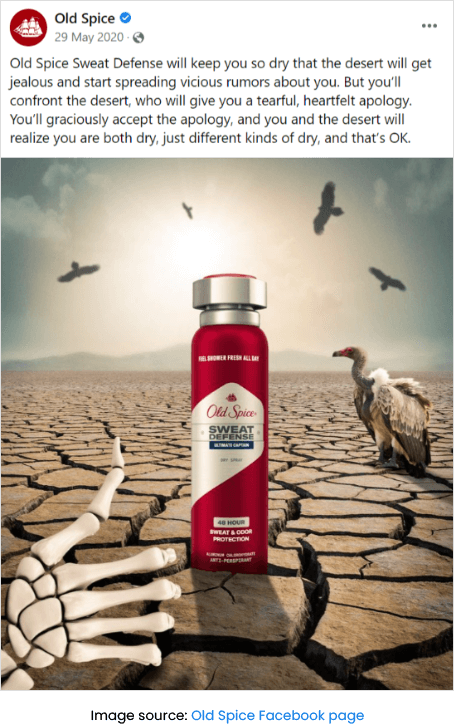
Old Spice is a men’s grooming brand that has become well known for its humorous ad campaigns. They often use humor in their social media content, creating engaging posts that easily go viral and get a lot of ha-ha reactions.
Example: Zendesk makes the serious world of B2B more lighthearted.
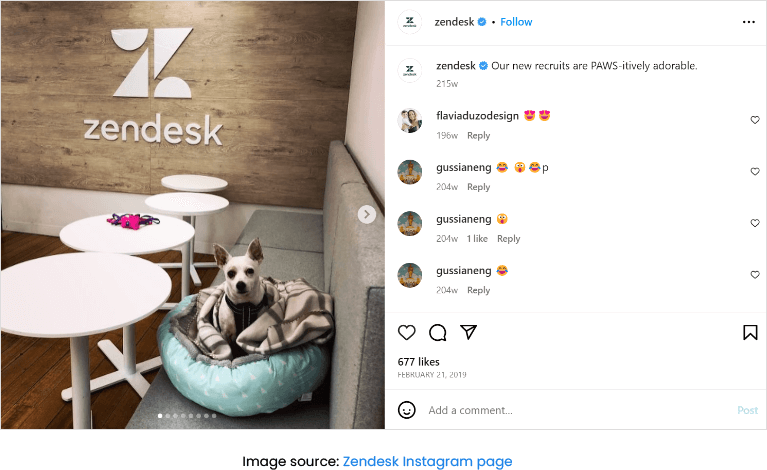
B2B companies often struggle to strike the right balance between professionalism and humor on social media. However, Zendesk has managed to master this art.
Their social media team knows how to create social media content by using humor. They have fun by adding value to their message, distinguishing their posts from competitors, and injecting a touch of playfulness into a typically serious B2B environment.
5. Hosting competitions
Hosting competitions is a great way to create social media content and drive engagement. You must consider three things to have successful contests.
One, offer a prize that’ll motivate your audience to participate. This could be a product, service, or experience that’s relevant to your brand.
Two, create clear rules. Make sure the rules of the competition are easy to understand. This will prevent confusion and ensure that everyone has a fair chance to participate.
Three, follow up. Once the competition is over, follow up with the winner and announce the results on social media. By the way, you can use this chance to thank everyone who participated.
Pro tip: Have a marketing strategy in place and determine your goal for hosting the competition. Do you want to attract more followers, increase brand awareness or drive sales? Let your goal guide the content, rules, and even the prizes of your competition!
Example: Coca-Cola encourages people to find a bottle with their name.
One example of a successful social media competition is the “Share a Coke” campaign. The rule was simple: you were supposed to find a bottle with your name on it or the name of someone you knew. Afterwards, you shared a photo on social media using the hashtag #ShareaCoke.
The campaign was a big success, generating over 500,000 photos shared on social media and increasing Coca-Cola’s sales by more than 2%. The company also created a website where people could personalize their own virtual bottles to share on social media, further increasing engagement with the campaign.
Markedly, the “Share a Coke” campaign demonstrated the power of personalization in social media marketing. And it has since been replicated by other brands with similar success.
6. Repurposing existing content
Rather than starting from scratch every time, repurposing existing content can save you time and energy. So, make the most out of content that you’ve already invested resources into creating.
You can transform a blog post into a social media graphic. A video into a blog post. Or a podcast into a series of social media posts. With the help of AI tools, you just need to pick a professional template and transform it into amazing graphics for your social media posts. Options are endless. Be creative and experiment with different approaches and formats to see what works best for your brand. Plus, when you mix up the types of content you share, you keep your audience interested and your social media channels – fresh.
Buzzfeed and the New York Times show us how to create engaging social media content and drive engagement.
Example: Buzzfeed reaches diverse audiences on multiple platforms.
Buzzfeed is a media company that creates a variety of content, including articles, videos, and quizzes. They often repurpose their content across different platforms, such as turning a popular article into a video for social media or creating a quiz based on an article. This allows them to reach different audiences and engage their followers on multiple platforms.
Example: The New York Times makes bite-sized versions of its content.
The New York Times creates a lot of long-form articles and investigative journalism pieces. They often repurpose this content for social media. Obviously, shorter versions of the content are more shareable on social media platforms. This allows the media giant to reach new audiences who may not have the time or interest to read the full article.
7. Offering a behind-the-scenes look at your company
Want to create a sense of exclusivity? Offer a backstage pass to your followers.
Offering a behind-the-scenes look at your company allows your audience to see the human side of your business. Also, it helps to get to know the people behind the products or services you offer.
Example: Slack gives a peek at their office and work culture
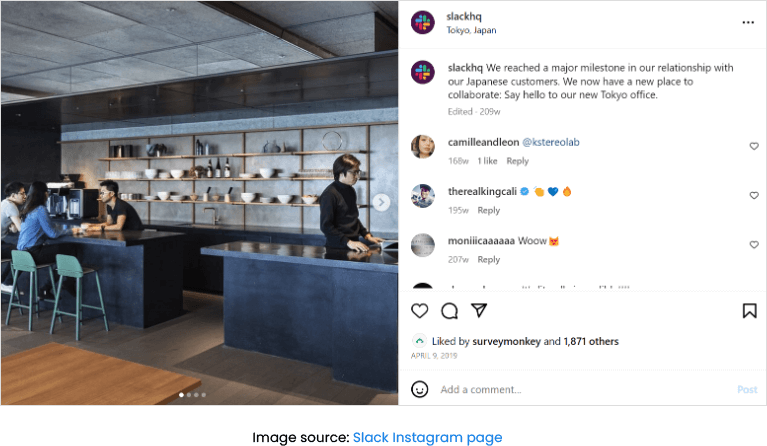
Here’s another example from Slack. They often share photos and videos on social media that showcase their corporate values and recent updates. This gives customers a sense of the people behind the platform and creates a more personal connection.
How to create engaging social media content: a bonus tip
No matter what approach you take to content creation, there’s one critical factor that could undermine your success and leave you with nothing. It’s the time you publish your content.
For the best results, use social media analytics tools to understand the behavior of your audience. Regularly track when your audience is most active and engaged. This data can help you identify the best time to post your content.
Once done with your plan on how to create social media content and when to share it, stay consistent. When you stick to a consistent posting schedule, you easily build a routine with your audience and drive better engagement.
Let’s sum it up!
It’s essential to create engaging social media content to achieve success in the digital world. When your followers are invested in what you post, they’re more likely to interact with your content. As a result, you generate more exposure for your brand.
Moreover, engaging content can help you to stand out from the crowd. With millions of posts being shared on social media every day, your content becomes unique, attention-grabbing, and memorable.
Thus, if you create content for social media that captivates your audience, you can establish a strong online presence and drive real results for your business.
















